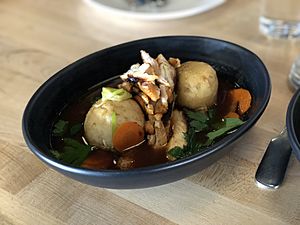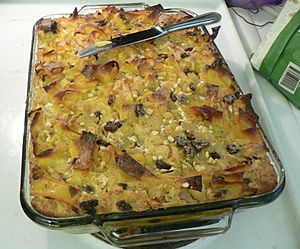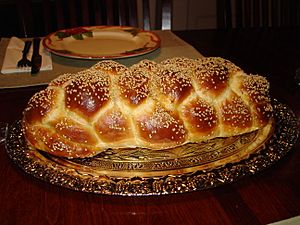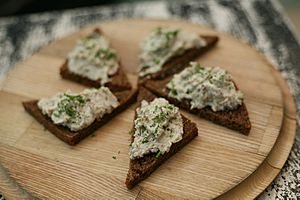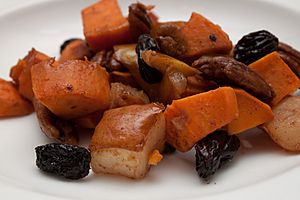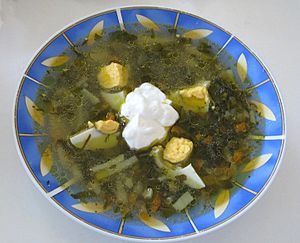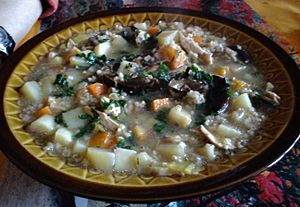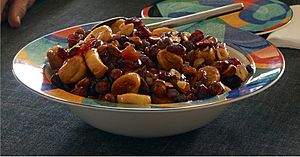Ashkenazi Jewish cuisine facts for kids
Ashkenazi Jewish cuisine is a special way of cooking that developed among the Ashkenazi Jews. These are Jewish people who originally lived in parts of Eastern, Central, Western, Northern, and Southern Europe. Today, many of their descendants live in the United States and other Western countries.
Ashkenazi Jewish foods are often unique to these communities. They use local ingredients like beets, cabbage, and potato. All these foods are prepared according to kashrut laws, which are Jewish dietary rules. Some of these ingredients were not popular with non-Jewish neighbors. This was because Jewish and non-Jewish communities often had limited interaction in the past.
This cooking style uses ingredients that were usually inexpensive. This was important because many Ashkenazi Jewish communities in Europe were historically poor. They used ingredients that were easy to find and buy in their regions. Some ingredients, like brisket (a cut of meat), chicken liver, and artichokes, were not often used by their non-Jewish neighbors.
In Europe, Ashkenazi Jews were often not allowed to own or rent land for farming. Because of this, their food has fewer vegetable-focused dishes. This is different from Sephardi and Mizrahi cuisines, which use more vegetables.
Meat is prepared using a special process called shechita. It is also soaked and salted. Meat dishes are very important for Shabbat (the Jewish day of rest), holidays, and celebrations. Braised meats like brisket are common. Root vegetables such as potatoes, carrots, and parsnips are used in dishes like latkes (potato pancakes), matzo ball soup, and tzimmes (a stew of fruit and vegetables, sometimes with meat). Stuffed vegetables like stuffed cabbage are also central to this cuisine.
Traditional Jewish cooking often uses olive oil. However, olive oil was not always available in Europe for Ashkenazi Jews. Instead, they used rendered fat from leftover poultry skins, called schmaltz. This fat was used in fleishig (meat) dishes. For milchig (dairy) dishes, butter was traditionally used. Today, many baked goods are made with vegetable oils, like canola oil. This makes them pareve, meaning they contain neither meat nor dairy.
Contents
History of Ashkenazi Cuisine
The food of Ashkenazi Jews tells the story of their journey. They moved from Central Europe to Eastern Europe, and then to the Americas and Israel. Ashkenazi Jews came together as a group in the Holy Roman Empire around 1000 CE. They gradually moved eastward. They settled in places like the Polish-Lithuanian Commonwealth, which included parts of modern-day Belarus, Estonia, Latvia, Lithuania, Moldova, Poland, Russia, Slovakia, and Ukraine. Ashkenazi communities also lived in the Banat region, which is now part of Serbia, Romania, and Hungary. Because of this, their cuisine was very regional in the past. It was also influenced by many European cooking styles, including German, Italian, Slavic, and even Ottoman foods.
People often say that Ashkenazi Jewish food is the food of poverty. This is because Jews in Europe often lived under the control of non-Jewish rulers. They faced antisemitic laws that sometimes limited their jobs or their ability to own land. This often led to poverty for many Jewish families. As a result, they mostly had basic foods. Luxury items like meat and imported spices were rare for most people. However, wealthy Jews could afford and enjoy these special ingredients.
Most Jews living in the Western Levant (parts of the Middle East) and Turkey since ancient times were Sephardic, Mizrahi, or other non-Ashkenazi Jews. But Ashkenazi communities also lived among Jewish groups in the southern Syrian provinces during the Ottoman period. There is evidence that Ottoman and Ashkenazi cooking styles influenced each other. You can see this in the food of Jews in the Banat, Romania, and Moldova, especially with dishes like pastrami and karnatzel.
Some people think Ashkenazi food has few vegetables compared to other Jewish cuisines. This was especially true in the late 1800s and early 1900s. During this time, many Eastern European Ashkenazi Jews faced extreme hardship, including a lack of food. This period also saw the rise of industrial food processing. In the mid-20th century, this trend continued in the United States. It led to fewer types of dishes and more reliance on processed, shelf-stable foods.
Historically, root vegetables were a big part of the Ashkenazi diet in Europe. These included turnips, beets, parsnips, carrots, black radish, and potatoes. The potato, which came from the Americas, greatly changed Ashkenazi cooking. However, most Ashkenazi Jews only started using potatoes in the second half of the 19th century. Other common vegetables were cabbage, cucumbers, sorrel, and horseradish. In the Banat region, tomatoes and peppers were also eaten. Cabbage and cucumbers were often preserved by pickling or fermenting them. Fruits included plums, apricots, apples, pears, and berries. These were eaten fresh or preserved. Common grains were barley, rye, buckwheat, and wheat. Barley and buckwheat were usually boiled. Rye and wheat were ground into flour for breads and baked goods. Dairy products were also common, such as sour cream and cheeses like farmer's cheese and brindze. Nuts like almonds and walnuts were eaten, and mushrooms were gathered or bought.
In North America, Ashkenazi food became simpler than it had been in Europe. This was mainly because some ingredients were not available. Also, industrial food processing and the desire to fit in played a role. However, in the early 21st century, there's been a growing interest in old recipes and food history. This has led to efforts to bring back and celebrate this unique cuisine.
Popular Ashkenazi Dishes
Baked Goods
The hamentash is a triangular cookie or pastry. It is filled with fruit jam (lekvar) or honey and black poppy seed paste. People eat it on the Purim holiday. It is said to be shaped like the hat of Haman, a villain from the Purim story. The mohn kichel is a round or rectangular cookie with poppy seeds. Pirushkes, or turnovers, are small cakes fried in honey or dipped in molasses. Strudel is a popular dessert pastry.
Kugels: A Type of Casserole
Kugels are a type of casserole. There are two main kinds: noodle or potato. Lokshn kugl, or noodle kugel, is usually made with wide egg noodles, eggs, sour cream, raisins, and farmer's cheese. It often has some sugar. Potato kugels (bulbenikes) are made from chopped or shredded potatoes, onions, salt, and eggs, with oil or schmaltz. A special dish from Jerusalem, kugel yerushalmi, uses long, thin egg noodles, more sugar, and a lot of black pepper. Noodle kugel is usually dairy, while potato kugel can be dairy, meat-based, or pareve (neither meat nor dairy).
Breads and Cakes
The dough for challah bread is often shaped into special forms. For example, on Rosh Hashanah (the Jewish New Year), it might be shaped into rings or coins. This symbolizes a wish for the new year to be "round and complete." For Hoshana Rabbah, bread is baked in the shape of a key. This means "May the door of heaven open to hear our prayers."
In Eastern Europe, Jews baked black ("ordinary") bread, white bread, and challah. The most common challah shape is the twist (koilitch or kidke). This bread is oval and about one and a half feet long. For special events like weddings, the koilitch might be even longer.
The bagel first came from Jewish communities in Poland. It is a very popular Ashkenazi food and became well-known in the United States.
Fats for Cooking
The melted fat from chickens, known as schmaltz, is often saved for cooking. Gribenes or "scraps" are the crispy bits left after rendering the fat. These were a favorite food in Jewish communities in Eastern Europe. Schmaltz is also eaten spread on bread.
Fish Dishes
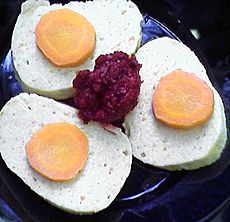
Since kosher meat was not always easy to find, fish became an important part of the Jewish diet. In Eastern Europe, fish was sometimes saved especially for Shabbat. Fish is not considered "meat" in the same way as beef or chicken. So, it can be eaten with dairy products. However, some Sephardi Jews (Jews from Spain, Portugal, and North Africa) do not mix fish and dairy.
Even though fish is parve (neither meat nor dairy), Orthodox Jews often eat it in separate courses from meat or dairy. They might even wash or change dishes in between. Gefilte fish and lox (smoked salmon) are popular in Ashkenazi cooking.
Gefilte fish (meaning "stuffed fish" in German) was traditionally made by taking the skin off fish steaks, usually German carp. The bones were removed, and the fish meat was minced. It was sometimes mixed with finely chopped browned onions, eggs, salt or pepper, and vegetable oil. The fish skin and head were then stuffed with this mixture and cooked in liquid.
A religious reason for having a boneless fish dish for Shabbat is to avoid separating bones from food while eating. This is a rule called borer.
Today, you can often find commercially packaged "Polish" gefilte-fish patties or balls. These are similar to quenelles. Sugar is added to the broth, giving them a slightly sweet taste. These are essentially the fish filling, not the whole stuffed fish. This way of serving came from the tradition of taking the stuffing out of the skin before serving.
While traditionally made with carp or whitefish, gefilte fish can also be made from other large fish. In the United Kingdom, cod, haddock, or hake are sometimes used.
The combination of smoked salmon or whitefish with bagels and cream cheese is a classic breakfast or brunch. It became famous in New York City delicatessens.
Vorschmack or gehakte hering (chopped herring) is a popular appetizer for Shabbat. It is made by chopping skinned, boned herrings with hard-boiled eggs. Sometimes onions, apples, sugar or pepper, and a little vinegar are added.
Meat Dishes
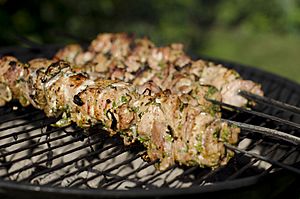
Holishkes, or stuffed cabbage, is another European Jewish dish. It came from times when Jews were poorer. In the Middle Ages, having a live cow was more valuable than eating its meat. So, Jews used fillers like breadcrumbs and vegetables to mix with ground beef. This made it seem like more meat was stuffed into the cabbage leaves.
A spread of chopped liver is a popular appetizer or snack. It is made with caramelized onions and often includes gribenes. It is usually served with rye bread or crackers.
Gebratenes (roasted meat), chopped meat, and essig-fleisch (vinegar meat) are favorite meat recipes. The essig (or honig or Sauerbraten) is made by adding sugar, bay leaves, pepper, raisins, salt, and a little vinegar to partially roasted meat. Knish is a snack food. It has a meat or potato filling covered with dough, which is then baked or grilled.
Side Dishes
Tzimmes usually has cooked vegetables or fruits, sometimes with meat. The most popular vegetable for tzimmes is sliced carrots (mehren tzimes). Turnips are also used, especially in Lithuania. In southern Russia, Galicia, and Romania, tzimmes are made with pears, apples, figs, prunes, or plums (floymn tzimes).
Kreplach are like ravioli dumplings. They are made from flour and eggs mixed into dough, rolled thin, cut into squares, and filled with seasoned meat or cheese. They are most often served in soup but can also be fried. Kreplach are eaten on various holidays, including Purim and Hoshana Rabbah.
Soups
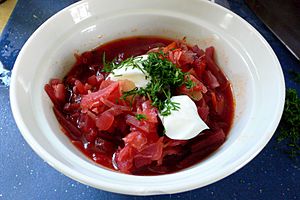
Many soups are typical Ashkenazi dishes. One of the most common is chicken soup. It is traditionally served on Shabbat, holidays, and special occasions. The soup can be served with noodles (lokshen in Yiddish). It is often served with shkedei marak (croutons popular in Israel), called mandlen or mandlach in Yiddish. Other popular additions are kreplach (dumplings) and matza balls (kneidlach). Matza balls are a mix of matza meal, eggs, water, pepper, or salt. Some people save kneidlach for Passover and kreplach for other special times.
Some soups are made without meat or fat. These soups were often the food of poorer people. An expression among Jews in Eastern Europe, soup mit nisht (soup with nothing), came from these kinds of soups.
Soups like borscht were a basic food in Ukraine. Shtshav, a soup made with sorrel, was often called "green borscht" or "sour grass." Soups like krupnik were made from barley, potatoes, and fat. This was the main food for poor students in yeshivot (Jewish schools). In richer families, meat was added to this soup.
At weddings, "golden" chicken soup was often served. It got its name from the yellow circles of melted chicken fat floating on top. Today, chicken soup is jokingly called "Jewish penicillin" and is thought to help cure the common cold.
There are several sour soups in the borscht family. One is kraut or cabbage borscht. It is made by cooking cabbage, meat, bones, onions, raisins, sour salt (citric acid), sugar, and sometimes tomatoes together.
Beet borscht can be served hot or cold. In the cold version, a beaten egg yolk might be added before serving. Each bowl is topped with a dollop of sour cream. This last step is called farweissen (to make white).
Krupnik, or barley soup, comes from Poland. Its name comes from a Slavic word for hulled grains, krupa. Non-Jewish krupnik recipes often mix meat (beef, chicken, pork) and dairy (sour cream). Jewish recipes for meat-based krupnik usually use chicken or beef broth. If made without meat, sour cream can be added.
Sweets and Candies
Teiglach are traditionally served on Rosh Hashanah, the Jewish New Year. They are small balls of dough, about the size of a marble, covered in a honey syrup. Ingberlach are ginger candies shaped like small sticks or rectangles. Rugelach, babka, and kokosh are also popular pastries.
In Europe, jellies and preserves made from fruit juice were used as pastry fillings or served with tea. Among the poor, jelly was saved for sick people. So, people would often say the Yiddish phrase Alevay zol men dos nit darfn (May we not need to use it) before putting it away.
Flodni was a layered sweet pastry with apples, walnuts, currants, and poppy seeds. It was a common item in Hungarian Jewish bakeries before World War II.
Compote became a basic dessert in Jewish homes across Europe. It was easy to make, used cheap ingredients, and had no dairy. Because of this, it was considered a part of Jewish cuisine.


